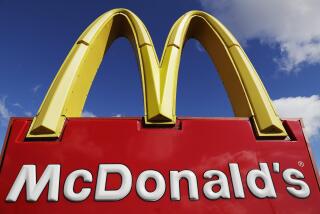Dining Well in a Jumbo-Portion World
- Share via
If you’ve been to a fast-food outlet lately, you’ve probably heard this refrain from the person at the counter: “Would you like to super-size that order?” The premise of super-sizing is simple: for an extra 50 cents or a buck, you get a bigger portion of French fries, soft drink or burger.
And it’s not just fast-food chains that are making this pitch to consumers. It’s also happening at sit-down restaurants and with frozen-food manufacturers and other food companies that are appealing to big eaters and bargain hunters alike.
Steven Grover, vice president of the National Restaurant Assn., says restaurants want to keep people in the habit of eating out by making them feel as if they’re getting a lot for their money. “Customers don’t view [it as] a good value if they walk away from a restaurant hungry,” he says. “When you eat at home, it’s commonplace to eat until you are full.”
Of course, the restaurants are also trying to boost sales and profits. Garver says that “super-sizing” is accounting for about one-third of sales on menu items, such as French fries, soft drinks and sandwiches, that are included in these special deals.
The strategy seems to be working. A survey by the restaurant trade group found that 43% of customers occasionally buy a larger portion so they can take it home for leftovers.
Marketing that appeals to bargain hunters is nothing new in the food business. Supermarket coupons, two-for-one restaurant meals and the smorgasbord concept have been with us for a long time.
Super-sizing is different, however, because it promotes a few select restaurant items, usually higher-profit ones such as soft drinks and fries. And these items are ones that are packed with extra fat, sugar and calories.
As more Americans than ever, including a growing number of children, battle obesity and other health problems such as heart disease and diabetes, one could question the social consciousness of a super-sizing strategy that emphasizes high-fat, high-calorie food.
It’s worth noting that Americans are consuming, on average, 8% more calories daily today than they did 20 years ago.
Melanie Polk, director of nutrition for the American Institute of Cancer Research, recommends that an average 170-pound male who is moderately active should consume about 2,500 calories a day and no more than 85 grams of fat. A 120-pound woman, also moderately active, should consume 1,800 calories and fewer than 60 grams of fat, she advises.
Here are some examples of how super-sizing can greatly increase your intake of calories and fat. At Jack in the Box restaurants, for example, a regular-size order of fries contains 16 grams of fat and 350 calories. But a Super Scoop of fries contains 28 grams of fat--nearly half the daily recommendation for a 120-pound woman--and 610 calories--more than a third of the recommended intake.
Bigger soft drinks can pile up the calories quickly. For example, a 16-ounce Coca-Cola Classic contains 190 calories and 48 grams of sugar. A super-size version, usually 32 ounces, doubles that to 380 calories and 96 grams of sugar.
Many McDonald’s restaurants offer an extra apple pie with a meal for just a few cents extra--often two pies for 99 cents. Two pies contain a whopping 520 calories and 26 grams of fat.
In October, the U.S. Department of Agriculture published a survey that compared what 5,752 adults nationwide “thought they ate” to what they actually consumed. The results were not surprising. Underestimates of consumption of grains, fats, oils and sweets. Overestimates on consumption of fruit, milk products, meat, poultry, fish, dry beans, eggs and nuts.
The study demonstrates that our perception of serving sizes often is quite different from reality. Other studies have found that far more people determine portion size by their hunger rather than the serving sizes included on food packages or those recommended by dietitians or the government’s food guide pyramid.
What is the correct serving size when eating out? Nutritionists and the AICR agree that plates of food should be divided into three equal sections. Vegetables, fruits, whole grains and beans should occupy two-thirds, and animal-source foods, such as meat, chicken and fish, should be one-third.
Controlling the portions we eat is easier said than done in everyday life. To help people get a handle on this, the AICR has created a new publication, “The New American Plate,” which has information on recommended food portions. The 36-page brochure is available free on the institute’s Web site, https://www.aicr.org, or by calling (800) 843-8114, Ext. 22.
Also, be aware that all major fast-food outlets post nutritional information in their restaurants and on their Web sites.
Of course, super-sizing can also be a way to feed a family for less money. My suggestion is to spend the extra money on something other than soft drinks or fries, such as an extra sandwich. While you may not be reducing the total fat or calories, you will at least be getting more protein.
And for the food industry, maybe it’s time to change the super-sizing rules. Instead of offering extra fries or an apple pie, why not an apple or banana for 25 cents more? Instead of creating ever-bigger sandwiches, how about a little healthy downsizing?
*
Phil Lempert hosts a national syndicated radio show and is the food correspondent for NBC’s “Today” show. He can be reached by e-mail at PLempert@aol.com. His column appears the first and third Mondays of the month.
More to Read
Inside the business of entertainment
The Wide Shot brings you news, analysis and insights on everything from streaming wars to production — and what it all means for the future.
You may occasionally receive promotional content from the Los Angeles Times.










